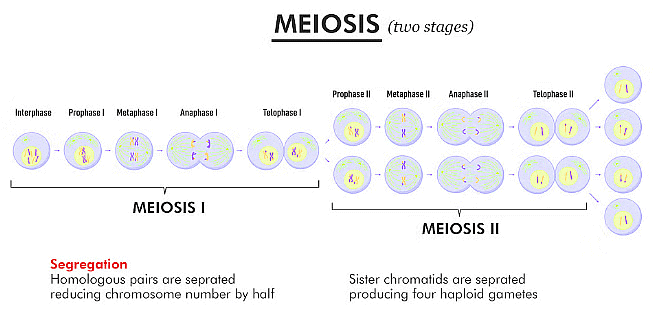Meiosis: Types, Stages & Significance | Biology Class 11 - NEET PDF Download
Meiosis
When a single cell divides into two or more cells, we say that cell division has occurred. The single cell that divides itself is known as a parent cell or parental cell. The resulting cells from the parent cell are known as daughter cells. A cell cycle can be defined as the sequence of events in which cell synthesizes the other constituents of cells by duplicating themselves and eventually dividing themselves into daughter cells.
Phases in Cell Cycle
Interphase:
- This phase is between the two successive phases of the M-phase. In this phase, the cell prepares themselves for cell division. Cells replicate their genetic material. Cells duplicate their organelles.
- This phase is between the two successive phases of the M-phase.
- In this phase, the cell prepares themselves for cell division.
- Cells replicate their genetic material.
- Cells duplicate their organelles.
It includes 4 phases:
- G1 phase: Phase in which most organelles duplicate themselves. This phase is the interval between the mitosis and initiation of DNA.
- G0 phase: Phase in which cells remain metabolically active but the cell doesn’t replicate themselves until they are asked to do so.
- S phase: Phase in which replication or synthesis of DNA occurs.
- G2 phase: Phase in which chloroplast, Golgi bodies, and mitochondria duplicate. This phase is the interval between the S phase and mitosis.
M-phase or Mitosis
Phase in which actual cell division occurs. In this phase, identical daughters are formed by cell division of their same constituents.
Cell Division
- Interphase: This is the phase in which cells prepare for division, including cell growth and DNA replication.
- Mitosis: During mitosis, a cell's nucleus divides into two nuclei with identical sets of chromosomes.
- Cytokinesis: This is the process where the cytoplasm divides, resulting in two daughter cells.
Meiosis is a type of cell division that produces gametes with half the number of chromosomes.
- Meiosis I: The first meiotic division involves the reduction of chromosome number.
- Meiosis II: The second meiotic division maintains the chromosome number.

Meiosis I
Prophase IIt is the first stage of meiosis I and is divided into several substages:
- Leptotene: Chromatin fibers condense, forming thread-like chromosomes.
- Zygotene: Chromosomes pair up in a process known as synapsis, forming bivalents.
- Pachytene: Crossing over of genetic material between homologous chromosomes occurs.
- Diplotene: Nuclei and nuclear membrane start to disappear, chiasmata form.
- Diakinesis: Chiasmata formation is completed.
Metaphase I
- Pairs of chromosomes align along the cell's equator.
- Spindle fibers from each pole attach to each chromosome pair.
- Centrioles are positioned at opposite poles of the cell.
Mitosis in Detail
Chromosomes Aligning on the Cell's Equator:
- During this phase, pairs of chromosomes position themselves along the cell's equator.
Attachment of Spindle Fibers:
- Spindle fibers at each pole of the cell connect to individual chromosomes within each pair.
Positioning of Centrioles:
- Centrioles are located at opposite poles of the cell during this stage.
Separation of Chromosomes:
- Through the action of spindle fibers, each chromosome in a pair moves towards opposite poles.
- Sister chromatids remain together at this point.
- Pair of chromosomes will be separated by the spindle fibers.
- Each pole will now hold one chromosome from the pair.
- The sister chromatids remain connected during this phase.
Completion of Chromosome Movement:
- Chromosomes finish their migration and reach the poles of the cell.
- A membrane forms around each set of chromosomes, leading to the creation of two nuclei.
- The nuclear membrane and nucleolus reappear during this phase.
- Chromosomes have finished their migration to the cell poles.
- A membrane forms around each set of chromosomes, resulting in the formation of two nuclei.
- The nuclear membrane and nucleolus reappear as part of the process.
Cell Division:
- Each parent cell divides to yield haploid daughter cells.
Interkinesis Phase:
- Interkinesis, occurring between telophase I and prophase II, is characterized by chromosome elongation without DNA replication.
Meiosis II
Prophase II
- Two daughter cells are generated, each containing condensed chromosomes visible in an X-shaped structure under a microscope.
- Centrioles duplicate during this phase.
- Spindle fibers are reformed.
- Chromosomes pair up and align along the cell's equator.
- Centrioles position themselves at opposite poles, and spindle fibers attach to chromosome pairs.
- Paired chromatids separate and move to opposite poles due to spindle fiber action.
- Each chromatid transitions into an individual chromosome.
- Chromatids reach the poles, decondense, and the nuclear membrane along with the nucleolus reappear.
- Four haploid nuclei are established.
- After Meiosis I, each daughter cell divides, yielding new daughter cells and transforming two haploid cells into four haploid cells.
|
150 videos|399 docs|136 tests
|
FAQs on Meiosis: Types, Stages & Significance - Biology Class 11 - NEET
| 1. What are the two types of meiosis? |  |
| 2. What are the stages of meiosis? |  |
| 3. Why is meiosis significant? |  |
| 4. How does meiosis differ from mitosis? |  |
| 5. What is the importance of crossing over in meiosis? |  |






















